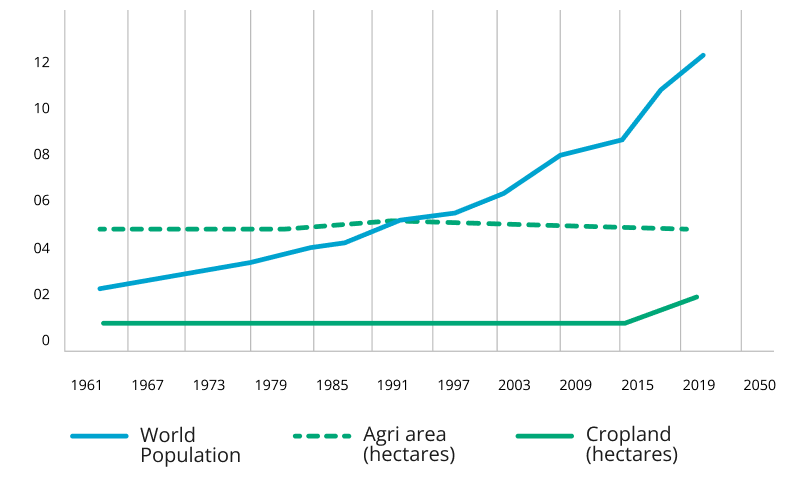
AgTech — Smart Solutions for Agriculture’s Major Challenges
Agriculture is in the middle of a digital transformation. As the global population continues to grow, farmers must produce more food — on the same limited land. At the same time, consumers demand higher-quality, sustainably sourced products, and factors such as labor shortages and climate change only add to the pressure.
Traditional farming methods are no longer able to meet these challenges. Agricultural businesses need to adopt AI, IoT, automation, and big data to optimize every stage of food production.
This article covers the key challenges facing agriculture today, the Ag technology solutions transforming the industry, and how SoftServe helps businesses implement AgTech to remain efficient, sustainable, and competitive.

Agriculture’s Growing Challenges
The farming sector has changed over the last 40 years. Today, it faces several increasingly urgent challenges requiring innovative agriculture technology solutions. Three of the biggest factors are a rising global population, an increasing consumer demand, and resistance to adopting new technology. Let’s take a closer look at each.
Feeding a growing population

By 2050, the global population is expected to reach nearly 10 billion, putting pressure on food production. With only about 11% of the world’s land arable, farmers will need to increase crop yields by roughly 70% per acre to meet demand.
Achieving this level of productivity requires disruptive technologies. Precision agriculture, data-driven decision-making, and automation are among the solutions that will be critical to ensuring food security in the coming decades.
Rising consumer expectations
Consumers today expect more transparency and higher-quality food. In the U.S. alone, organic sales reached $69.7 billion in 2023, a 3.4% increase from the previous year. A 2024 survey found that half of U.S. consumers believe organic products are healthier and better for animal welfare. At the same time, concerns over pesticides, allergens, and food-borne illnesses have made traceability a priority.
Major retailers like Amazon (through Whole Foods) and Walmart have expanded their organic offerings in response. However, with less than 1% of U.S. farmland certified organic, supply struggles to keep pace. AgTech innovations can help make organic farming more efficient and improve traceability across the supply chain.
Overcoming resistance to technological adoption
Globally, agriculture remains one of the least-digitized industries. Issues including an aging workforce, high implementation costs, and knowledge gaps are slowing down the adoption of AgTech. On top of that, funding in the food and agriculture technology market dropped 49% in 2023, with only $15.6 billion raised.
Agtech Solutions Transforming Agriculture
There are seven key AgTech solution areas, many of which overlap. Whether used individually or together, these solutions incorporate tools and technologies to address the sector’s growing challenges.
1. Internet of things (IoT)
IoT connects specialized equipment, sensors, and software to reduce waste, manual labor, and costs while increasing overall yields and productivity. Sensors measure soil moisture, temperature, and electrical conductivity, providing real-time insights. This data enables precision irrigation, targeted fertilization, and predictive analytics for optimized resource allocation. IoT often serves as the digital foundation for other solutions, including robotics, sensors, drones, and GPS technologies.
Traditional vs. Digital: Traditional farming relies on manual field assessments, which can lead to inefficient irrigation and fertilizer use. IoT-driven insights ensure resources are used only when and where needed, reducing waste and improving crop yields.
Learn more about SoftServe’s IoT capabilities2. Sensors and actuators
Advanced sensors give farmers vital data on soil health, climate conditions, and crop status. For instance, pH sensors detect nutrient levels in the soil, helping optimize crop growth, while temperature sensors alert farmers when the soil or air becomes too hot or cold for specific crops. With real-time data, farmers can make informed decisions that enhance productivity and sustainability.
Traditional vs. Digital: In conventional farming, decisions often rely on experience and observation, which can lead to inconsistent results. Sensors, on the other hand, provide accurate, real-time data, allowing for precise adjustments to improve crop health and yield.
3. GPS and geospatial technologies
GPS is used to map farmland and fields with precision. This helps farmers better understand the impact of their production methods and identify any crop issues early on. GPS also ensures seeds are planted in the best areas of the field, maximizing yield. It can also guide machinery, such as driver-optional smart tractors to the correct locations.
GPS is often combined with technologies like IoT or machine learning, helping farmers assess changes, solve problems, predict outcomes, and gather valuable insights.
Traditional vs. Digital: Traditional methods rely on manual mapping and inconsistent planting patterns. GPS-guided planting ensures optimal seed placement, reducing waste and improving efficiency.
4. Drones and imaging analytics
The AgTech sector is gradually adopting drones and unmanned aircraft, mainly to capture high-resolution images of crops. These images are then analyzed using software to monitor growth, detect pest infestations, and assess irrigation needs. This allows farmers to take action before issues escalate. While drones have been less commonly used for remote fertilization, this trend is growing as GPS technology and sensors continue to improve.
Traditional vs. Digital: Visual inspections are time-consuming and may overlook early-stage issues. Drones provide comprehensive field coverage in minutes, identifying problems before they escalate.
5. Big data and machine learning
Big data and machine learning turn raw information into actionable insights by analyzing data from sources such as satellite and drone imagery, soil sensors, and moisture probes.
IoT devices placed in tractors, trucks, fields, and even plants collect real-time data directly from the ground. This data is then combined with external factors, such as weather conditions and market trends, to identify patterns and make informed predictions. These insights — generated by analysts or machine learning algorithms — help farmers detect inefficiencies, monitor soil quality, and predict potential issues before they arise.
Traditional vs. Digital: Farmers have traditionally relied on experience and trial and error. Machine learning replaces guesswork with data-driven insights, leading to smarter, more efficient decision-making.
6. Robotics and automation
Automation is advancing rapidly as labor shortages and the need for efficiency grow. Technologies like driverless tractors and robotic weeders reduce manual work while improving precision.
For instance, SoftServe’s Smart Agricultural Robotics solution fully automates tasks like plant monitoring, transplanting, and harvesting. AI, robotic perception, and closed-loop orchestration speed up large-scale automation.
Traditional vs. Digital: Manual labor is expensive and time-consuming. Robotics take over repetitive tasks, cut costs, and boost farm efficiency.
Learn more about SoftServe’s expertise in robotics and advanced automation7. Precision equipment
Smart farming machinery integrates multiple AgTech solutions to improve efficiency. GPS-guided tractors, automated irrigation systems, and AI-powered harvesting equipment help farmers streamline operations, cut costs, and reduce environmental impact.
How Softserve Enables the Future of Smart Agriculture
The need for innovation in agriculture has never been greater. SoftServe helps agricultural businesses adopt cutting-edge technology to solve industry challenges. Our expertise in AI, IoT, cloud computing, and data analytics powers precision agriculture, improves supply chain transparency, and enables smart farm management.
Our AgTech solutions include:
AI-powered analytics: Predictive insights for yield forecasting, climate impact analysis, and pest management.
IoT-driven monitoring: Real-time tracking of soil conditions, crop health, and farm equipment performance.
Automation and robotics: Smart irrigation, autonomous machinery, and precision harvesting technologies.
Cloud-based platforms: Centralized farm management systems for seamless data integration and remote monitoring.
Final Thoughts
Agriculture is facing growing challenges that require smart, technology-driven solutions. AgTech provides a way forward. IT solutions help farmers boost yields, meet consumer demands, and optimize resources sustainably. SoftServe is leading this transformation with innovative solutions. Reach out to us, and let’s explore how we can help you improve efficiency, sustainability, and growth in your farming operations
Start a conversation with us
